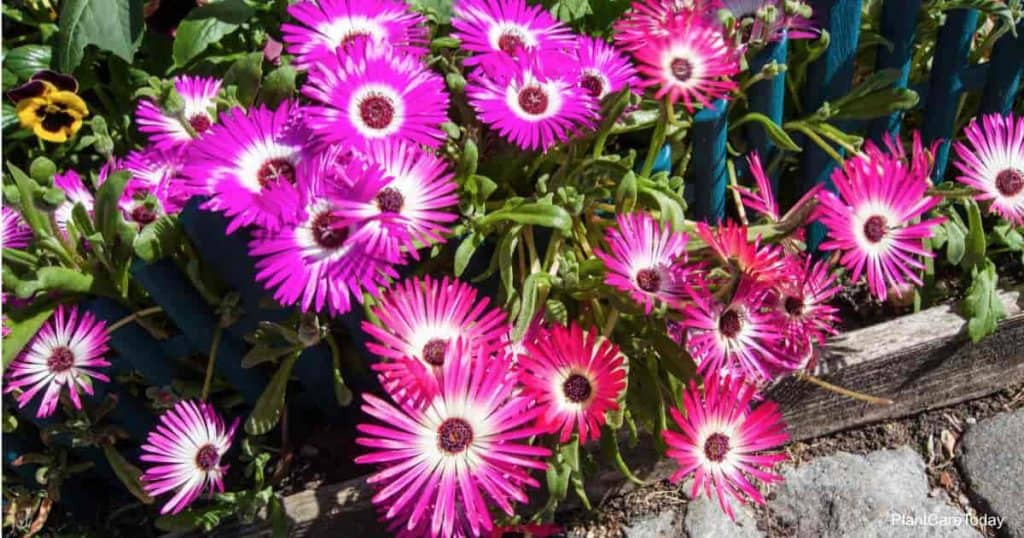Want to light a floral bonfire? Then try some plants of the mesembryanthemum group (ice plant) in your garden or on your pot plant shelf.
Probably no other plants offer such eye-stopping, dazzling color, and few are less demanding.

Mesembryanthemum – Easier To Grow Than To Say
The most difficult thing about the mesembryanthemums is their names.
At one time, all the more than two thousand species were members of the same tongue-twistingly-named genus, the Mesembryanthemum (mes-em-bree-ANTH-em-urn) or mid-day flower, a reference to their being open only for the sunniest part of the day.
Then, the botanists got busy and divided the genus into 120 genera.
This wasn’t done, as some gardeners believe, just to make matters difficult, but because differences in flowers and fruit made it impossible to leave the whole group together. The rules that define a genus were being broken.
Species names mostly remained the same, but the genera changed except for a few plants which remained in the original genus. Thus, Mesembryanthemum edulis became Carpobrotus edulis.
If you’re one of those accustomed to calling the mid-day flower mesembryanthemums and, having mastered this difficult name, are not about to attempt to learn others, all is still not lost.
The group of genera has been put together in a subdivision of the carpetweed family (Aizoaceae) called Mesembryanthemaceae – and you can go right on calling them the mesembryanthemum group if you like.
All the plants in this subdivision have satiny, fringe-like petals. Most are natives of South Africa, though a few come from southern California, Mexico, South America, and even Australia.
Garden literature has written much about mid-day flowers preferring thrifty, even sterile soil. I have not found this soil recommendation to be true.
The mid-day flowers will indeed survive and flower in extremely sandy soil with little or no leaf mold or fertility. I have seen them also blooming in humus-rich mud taken from the bottom of a canal.
We have found in our own garden and pot gardening experience and have observed in other gardens and other areas that flowers are the largest and plants most healthy if given a relatively rich soil mixture.
For most of them, try a mixture, of half leaf mold and half sandy loam, with a bit of added lime, for either pot use or a garden outside.
Diet For a Mesembryanthemum
We’ve found that much the same is true about watering and fertilizing.
Mid-day flowers will do well with no fertilizing program and little water, but they’ll do much better, particularly if grown in pots and treated to plenty of each.
Try a balanced liquid fertilizer once every three weeks and water whenever the soil is dry during the spring-summer-fall growing season.
During the winter rest, give no fertilizer and water only often enough to keep the plant’s succulent leaves from becoming seriously withered.
If mid-day flowers do well enough without any special watering, fertilizing, or soil, they are, nonetheless, very insistent about two things:
- Full sun
- Protection from cold
In partial shade, flowering will be sparse; in full shade, you’ll have trouble keeping the plant alive. Freezing temperatures are often fatal, and much below freezing is always fatal.
Propagation of most mid-day flowers is easy from cuttings taken in early spring, though they’ll root at other seasons almost as quickly.
Some, like the pebble plants, are best propagated by division of clumps, and others, like ice plants, are easily grown from seed.
A close relative is the trailing mesembryanthemum, Drusanthemum floribundum.

It is a perennial, and has round sparkling leaves and masses of pink blooms in spring.
If not in a traffic area, it makes an excellent ground cover in mild climate zones. Try it for a handsome pot plant further north.
Try An Aptenia!
Another trailer with sparkling, heart-shaped leaves is the creeping ice plant, Aptenia cordifolia.
Its small, bright magenta blooms appear in the spring and early summer, but it is fully as attractive for its leaves – every cell seems to sparkle, causing leaves to reflect the sun like millions of tiny gems.
There is also a variegated form. Aptenia is useful as an out-of-traffic ground cover, particularly on slopes, in mild climate zones, and as a pot plant further north.
by Phil Clark | Edits by PlantCareToday Staff
Recommended Reading
- Oscularia Deltoides – Pink Ice Plant Succulent
- How To Grow Succulents Outdoors In The Garden
- How Many Types Of Succulents Do You Grow?
